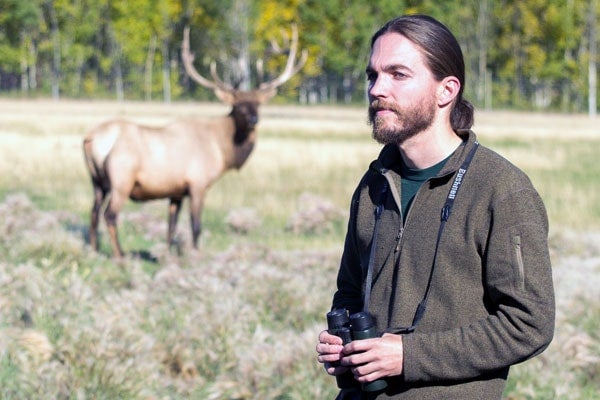
Working north of 60: Museum Studies grad manages visitor experience at Yukon Wildlife Preserve
Published: March 4, 2015
Most of us drive or use transit to get to work, but Jake Paleczny, a 2012 Museum Studies grad, sometimes skis to his job as director of programming and education at the Yukon Wildlife Preserve. Featuring more than 160 animals in a “living collection” on 700 acres, the preserve is about a 30-minute drive from Whitehorse.
How did you find yourself in the Yukon?
My folks were living there, so after visiting them a few years ago, I expanded my job search. The wilderness appealed to me, and the artiness of the place. There’s a great sense of community, and so much to do, like canoeing and hiking. It’s a great place to live and work.
So the cold doesn’t bother you?
I enjoy a good winter. And after you’ve experienced -35 for a week, -20 seems the perfect temperature for being outside!
Your office sounds like it’s in a beautiful setting. What does your actual job entail?
I manage the public side of the Yukon Wildlife Preserve – the visitor experience, our guided tours, the nature camps and school programming, as well as our social media content, newsletters and website.
Have you introduced anything new?
We’re using social media a lot more to communicate with the public. For example, we gave cameras to our nature camp instructors and asked them to take pictures all week. At the end of the week, we had about 50 photos, which we sent to parents and put on Facebook. It gives them and the public a chance to see what we’re doing.
What’s the goal of your programming?
“Nature deficit disorder” is a term coined several years ago to describe the negative side effects of how kids nowadays are growing up with a lot of structured, indoor time. That’s on our minds a lot. We are in a natural setting but we have fences, so we can do some interesting activities – big, forest-running games. It’s an environment that’s safe but allows kids to explore and have formative experiences with nature.
Science and biology are part of the learning experience but there’s a cultural element as well, isn’t there?
Yes, in our Grade 7 caribou program, for example, we blend the ecology with contemporary Yukon culture and First Nations culture. We take the group into the caribou pasture to look at tracks, follow tracks and see the caribou up close in their natural environment.
How did your degree prepare you for this job?
There was a good emphasis on practical experience. Most museums in Canada are quite small – so whatever position you take, you do many different things. Having the background provided by U of T’s Museum Studies program means there are fewer surprises in the job and you’re more competent in a wider variety of situations.
Tell me something interesting you’re doing at work this week.
Last night I started a YouTube channel for the wildlife preserve and put up the first video. It’s about our new moose, and I shot and edited it myself. We have two moose now.
Just two?
It’s about managing our collection. Not everyone sees a zoological facility as a museum but we have a collection and a curator – she’s a vet – and we have a plan to maintain a healthy collection into the future. We only have two or three moose at any given time because they are typically solitary animals.
I’m guessing you don’t spend all day at a desk. Do you interact much with the animals?
We do have a full animal care staff, but occasionally we help them out when they need an extra set of hands. There’s a show on National Geographic Wild called Dr. Oakley, Yukon Vet. A good portion of that show is filmed here, and in one of the episodes we had to catch lynx kittens to give them a booster shot. That was pretty exciting.
Have you ever had any scary encounters, like with a grizzly bear?
I was skiing to work one day and I saw what I thought were dog tracks on the trail. It looked like a big dog, and I was surprised there were no people tracks next to them. When I came over the top of a hill, I found the remains of a deer spread all over the trail. I spent the rest of the trip looking over my shoulder for wolves.
Arriving at work must have been a huge relief! What’s your favourite part of the job?
The variety – you’re constantly learning and getting to try new things. It’s a small organization so you can focus on things that you think are important.
(This article appeared originally in U of T Magazine; read more U of T Magazine stories)



